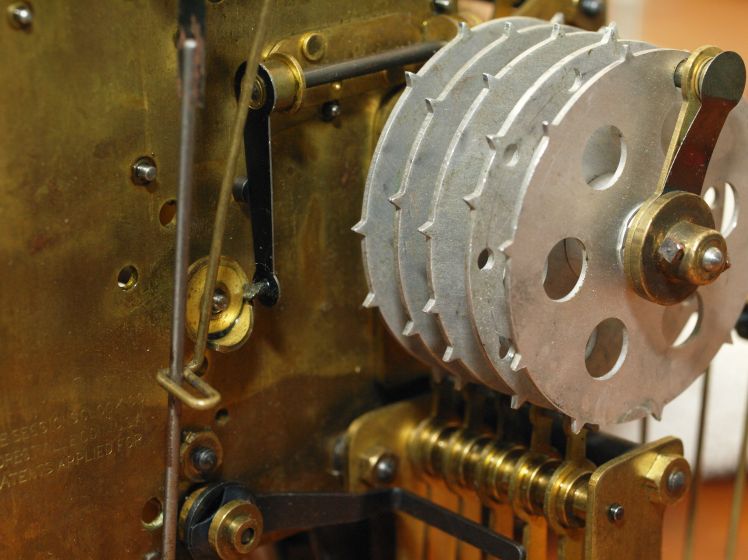Tick-Talk Tuesday is about the letters and comments I have received from you, the reader, concerning your clocks, issues you might have had and challenges you face and my responses to your questions with advice on your particular clock concern(s). For those comments and questions that stump even me, I consult within my clock circles for the best possible answer.
This is a Sessions Westminster A mantel clock made in Forestville Conn. The first year of production for this model was 1927. This particular clock was made in October of 1930 and features minor improvements to parts of the chime / strike train. Between 1903 and 1933 Sessions produced this and 51 other models of mechanical clocks, ranging from Advertisers, large and small clocks with logos of various businesses, to wall, or regulator clocks, and shelf or mantel clocks, designed for the home. Many of the Sessions clocks from this period are prized by collectors.
Everything seems to working very well with my clock except for the chimes which seem to have a rather peculiar problem
JD writes. “I stumbled across your WordPress blog about your Sessions Westminster clock and thought I’d reach out as I’m in the process of finally getting mine running. Everything seems to working very well with my clock except for the chimes which seem to have a rather peculiar problem. The hourly chimes work great. Full Westminster, then the correct number of hour strikes. The half hour chimes are also correct. The problem is that the quarter hour & three-quarter chimes are reversed. The quarter hour has 12 notes and the three-quarter hour has only 4. I haven’t even taken the movement out of it’s case yet, and at this point I’m just trying to figure out what the problem might be, and how complicated it may be to resolve it. This is one of about a dozen old clocks that my father had in his collection when he passed away, all of which I had been led to believe were non-functional. I’ve got ten of them running and would like to get an idea what I’m up against with this peculiar problem. Thanks in advance for any insight you may be able to offer.”

Co-incidentally I have been working on the same clock. Mine also had issues with the strike and chime sequence. I received JDs letter prior to working on my Westminster A mantel clock so I could not advise him on his specific issue but hope to share my experience with him once I have completed work on it.
The Sessions Westminster A mantel clock was made in Forestville Connecticut, USA. The first year of production for this model was 1927. Between 1903 and 1933 Sessions produced 52 models of mechanical clocks, ranging from advertisers, large and small clocks with logos of various businesses, to wall, or “Regulator” clocks, and shelf or mantel clocks, designed for the home. Many of the Sessions clocks from this period are prized by collectors. Having a unique and innovative design, the Westminster A is particularly sought after.

My reply was. ” Thanks for your letter JD. I have yet to tackle this clock and know that it is not a good clock for the novice clock repair person to work on. If you have the skill-sets to have worked on other clocks then you are prepared for this one. I have attached a detailed guide which will help you through the servicing of this clock. It was prepared by Robert Croswell a member of NAWCC. One thing I should mention. The clicks are very weak on this clock and click failures are common. I need not remind you that when clicks fail they may also take parts of a clock with them. If you decide to tear it apart, do yourself a favour and replace the clicks. I have a number of clocks that I have to service before I get to the Westminster A. Let me know how you are progressing with the clock and any insights you can pass along to me.”

I attached Robert Croswell’s excellent manual called Taming the Sessions 2-Train clock.
JD wrote back, “Thank you very much for the reply, and especially for the very helpful guide. I also asked the question on JustAnswer.com and received a helpful response from a clock repairer who said that the chime correction cam that is behind the locking plate needs to be rotated 180 degrees after it chimes the 12 notes, to the 3/4 hour position. As I said, I haven’t even removed it from the case yet so I just wanted to get an idea how involved the repair might be before I take any action. Now I have an idea where to focus my attention, and I can at least remove it from the case and examine it to fully understand the working of the chiming mechanism. Not sure if I’m up to tearing it apart quite yet, especially since it is running well for the most part. The resource you provided will no doubt prove very helpful to my learning process. I’ll let you know if I manage to resolve the issue and of course, anything I learn along the way. Thanks again.”
I will be sharing my experience with JD once I have the clcok running as it should. I have assembled the clock and in the process of testing the time side. Although the racks and snails (there are 2) are reinstalled I have not yet managed to have the time properly aligned. Once I have determined that the going train will run it’s full cycle I will focus on adjustments to the strike and chime side racks and snails.
A great learning experience.

Great Blogpost Thanks for sharing.
LikeLike
Thanks for dropping by.
LikeLike